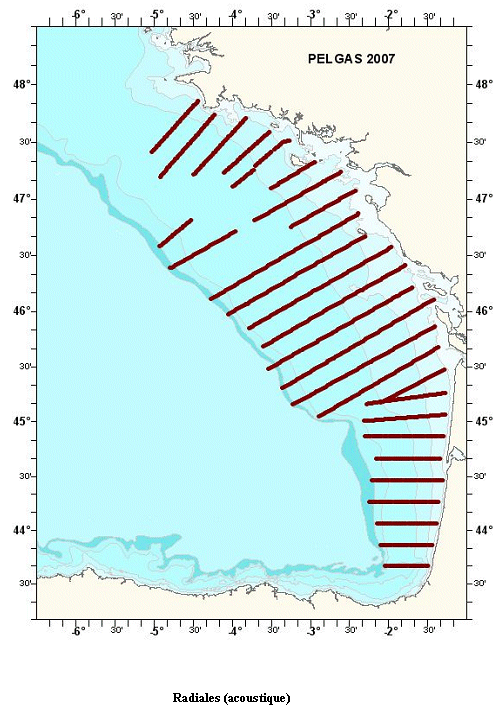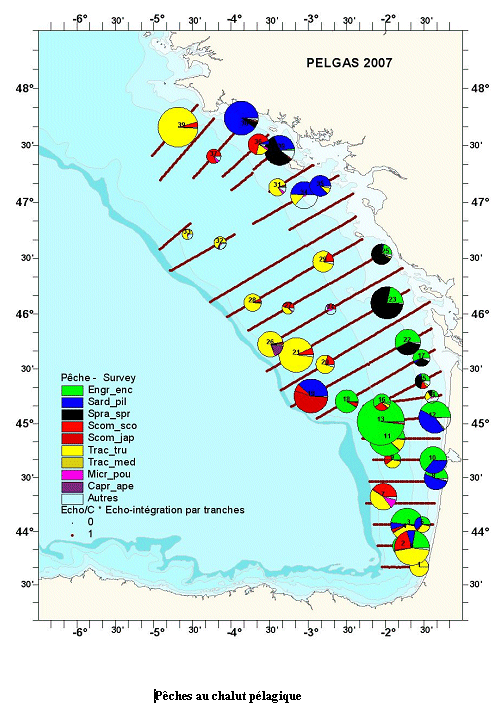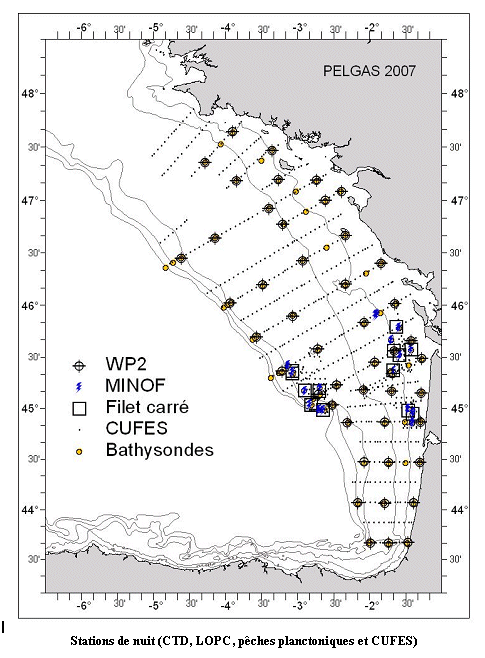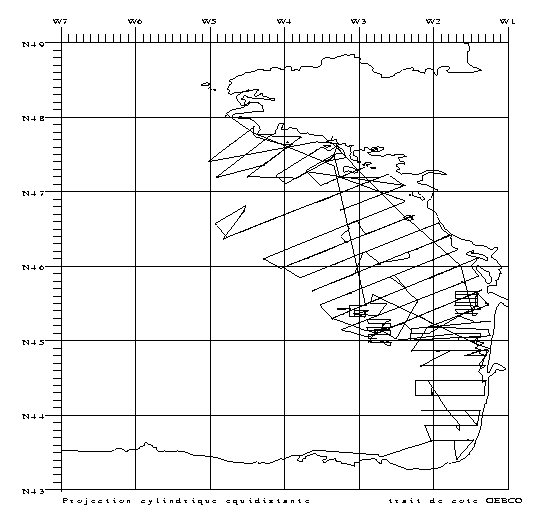| Sea/Ocean |
Bay of Biscay (
) |
| Ports |
Port of departure : Santander (Spain)
Port of return : Brest (France)
|
| Scientific Authority |
ÉCOLOGIE ET MODÈLES POUR L'HALIEUTIQUE Centre Ifremer de Nantes Rue de l'Ile d'Yeu 44311 Nantes Cedex 3 +33 (0)2 40 37 41 67 |
| Participating bodie(s) |
IFREMER - Nantes, Sète, Lorient, Boulogne s/mer, Brest / Université - La Rochelle / CNRS - La Rochelle / EPHE - Perpignan / CRMM - La Rochelle /
AZTI - St Sébastien (Espagne) / IEO - Gijon (Espagne).
|
| Discipline(s) |
- PHYSICAL OCEANOGRAPHY
- BIOLOGICAL OCEANOGRAPHY
- ENVIRONMENT
- FISHERIES
- CHEMICAL OCEANOGRAPHY
| Code |
Label |
Quantity |
PI |
| B02 |
Phytoplankton pigments (eg chloroph Fluorescence |
81 stations |
PLANQUE Benjamin |
| B09 |
Zooplankton |
47 stations |
DUPUY Christine |
| B13 |
Eggs & larvae CUFES + vertical fishing |
725 |
PETITGAS Pierre |
| B14 |
Pelagic fish Sizes (+ weights, otoliths, samples) |
18221 observations |
MASSE Jacques |
| B25 |
Birds |
1199 observations |
VAN CANNEYT Olivier |
| B26 |
Mammals & reptiles |
28 observations |
VAN CANNEYT Olivier |
| B28 |
Acoustic reflection on marine organ Continuous acquisition (in hours of recording) |
412 hours |
MASSE Jacques |
| B65 |
Exploratory fishing Pelagic trawls, or mesozooplankton |
48 hauls |
MASSE Jacques |
| B90 |
Other biological/fisheries meas. Samples for genetic analysis |
1150 specimens |
LENFANT Philippe |
| G73 |
Single-beam echosounding 5 frequencies (18, 38, 70, 120, 200 kHz) in h |
412 hours |
MASSE Jacques |
| H09 |
Water bottle stations Chlorophyll, microzooplankton |
35 stations |
DUPUY Christine |
| H10 |
CTD stations T, S, Fluo profiles |
81 stations |
PLANQUE Benjamin |
| H11 |
Subsurface meas. underway (T,S) T, S, Fluo (in nm) |
2500 |
PLANQUE Benjamin |
| H71 |
Surface measurements underway (T,S) Thermosalinometer |
- |
MASSE Jacques |
| M06 |
Routine standard measurements Wind and weather station |
- |
MASSE Jacques |
|
| Summary of measurements |
- -Acoustic exploration (acquisition and storage of signals on 5 frequencies) for the distribution and abundance of pelagic fish species, mainly anchovies and sardines.
-Pelagic (or bottom, or mesopelagic) trawl fisheries to identify target species and characterize resources (size distributions, demographics, biological characteristics).
-Egg counts using surface pumping with the CUFES system to determining spawning zones.
-Taking samples on adult sardines and anchovies for genetic analyses to distinguish whether different "groups" exist in the Bay of Biscay.
-Catching plankton to characterize the biotic environment of small pelagic fish populations (biochemical indices descriptors of zooplankton dynamics).
-CBT stations and continuation observation to describe hydrological conditions by associating available satellite photos and circulation modelling results following the model developed by P. Lazure.
-Characterizing the diversity and abundance of microzooplankton as well as other plankton compartments in order to evaluate the structure of the plankton food web.
-Identification and visual counts of cetaceans and birds present in the area to describe higher predators in the pelagic ecosystem of the Bay of Biscay.
-Density column used to study vertical migration of eggs in the water column.
|
| Location map |
|
| Positionning system |
Geodetic system : WORLD GEODETIC SYSTEM 1984 = WGS84
Positioning system : GPS différentiel
|
|
| Joint document(s) |
|
|





